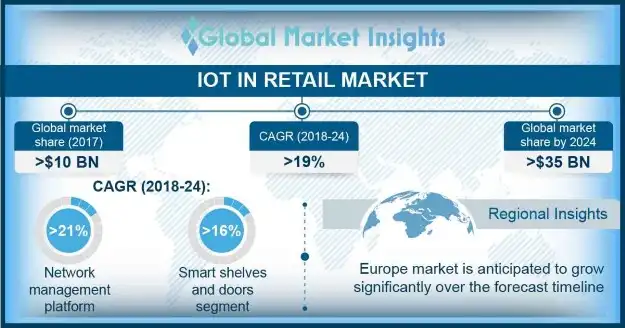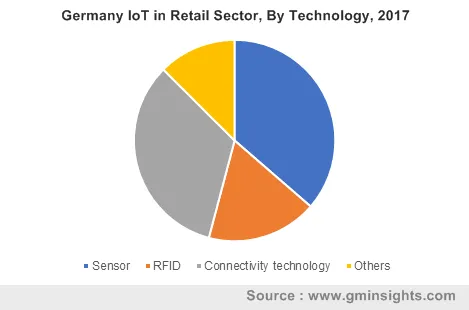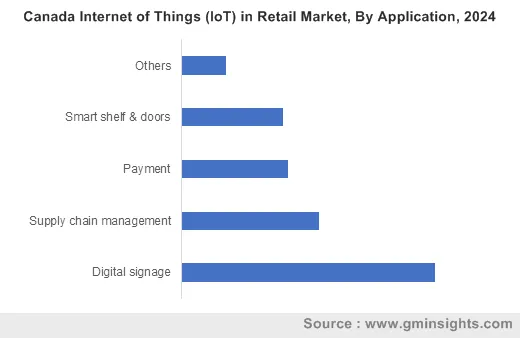


IoT in Retail Market
Get a free sample of this report
Your inquiry has been received. Our team will reach out to you with the required details via email. To ensure that you don't miss their response, kindly remember to check your spam folder as well!
Form submitted successfully!
Error submitting form. Please try again.

Request Sectional Data
Your inquiry has been received. Our team will reach out to you with the required details via email. To ensure that you don't miss their response, kindly remember to check your spam folder as well!
Form submitted successfully!
Error submitting form. Please try again.
IoT in Retail Market size valued at USD 10 billion in 2017 and will grow at a CAGR of over 19% from 2018 to 2024.

The growing focus of global retail companies and stores to transform into experience-based retailers by adopting IoT technology is driving the IoT in retail market growth. With the implementation of AR, VR, and data analytics tools, retailers can enhance online & in-store shopping experience and gain a high customer base. Increased adoption of digitization & automation across various industries including the retail sector to gain the operational efficiency benefits is adding up to the demand. The benefits associated with these technologies including strategies for new product development, existing product performance, and optimizing the store layout are compelling retailers across the globe to adopt IoT solutions. Additionally, continuous technical enhancements in network platforms, devices, and professional services that aid in improving the store management efficiency will support the market growth.
| Report Attribute | Details |
|---|---|
| Base Year: | 2016 |
| IoT in Retail Market size in 2016: | 10 Billion (USD) |
| Forecast Period: | 2018 - 2024 |
| Forecast Period 2023 - 2032 CAGR: | 19 |
| 2023 Value Projection: | 35 Billion (USD) |
| Historical Data for: | 2013 - 2017 |
| No of Pages: | 150 |
| Tables, Charts & Figures: | 168 |
| Segments Covered: | Platform, Technology, Component and Region |
| Growth Drivers: |
|
| Pitfalls Challenges: |
|
The lack of knowledge & awareness among retailers in small & technically backward economies is a factor limiting the industry growth. Store owners and supermarkets in these countries are unaware of the benefits associated with internet-based technologies and have limited investment capabilities. The rapid development of the global retail industry and the popularity of digitized products will help in overcoming these issues over the forecast timespan.
The network management platform in the IoT in retail market is expected to grow at over 21% CAGR from 2017 to 2024. The platform offers opportunities to service providers to serve the consumers better by managing the complex network issues. Network management platforms are gaining popularity to cater to the increasing demands for connected network and devices. The electronic devices, such as computers & printers in the IoT solutions, require timely monitoring and maintenance owing to the connectivity threats. Companies offer efficient network management platforms to IoT consumers, aiding them in saving maintenance costs and keeping the IoT networks upgraded. For instance, in February 2019, Cisco announced the launch of its IoT-enabled hardware, which offers intent-based networking and can be operated through the Cisco DNA Center.

IoT platforms deliver large amounts of data to the connected devices and communication networks by deploying several sensors such as temperature, image, proximity, pressure, chemical, level, and IR sensors. Different sensing components offer varied advantages in several applications including automotive, retail, electronics, etc. The declining cost of sensors across the globe enables companies to deploy them in even smaller internet-based solutions. The key function of these components in enhanced devices is to collect the surrounding information and forward it to management systems. For instance, image sensors in the retail industry monitor customer visits in stores through the connected network and notify the staff to provide better customer assistance.
Companies providing IoT platforms and solutions offer several professional services that include installation, consulting, and training for the retailers. These companies also provide managed services such as maintenance, upgrades, and repairing of the IoT offerings. These managed services are provided to global customers through the company’s direct facilities or third-party dealers. A major segment in service provision is independent IoT service providers that include certified personnel and trained individuals. For instance, IBM Corporation provides enterprise asset management & facilities management services for the retail segment through its professional and expert employees.

Smart shelves and doors segment are expected to grow at a CAGR of over 16% from 2017 to 2024. These are increasingly deployed in the supermarkets, shopping malls, and grocery stores to gain an advantage of the automated product tracking systems. RFID readers, tags, and antenna are the key components of smart shelves that provide real-time in-store inventory data to retailers. These solutions automatically alert store managers to refill the inventory & dispose the expired products. The smart shelves also provide customer behavior insights to the retailers by monitoring information about product movements. The information is used to judge customer purchase and aid them in improving future purchases.
The European retail sector is witnessing the impact of IoT solutions in terms of logistics & inventory management and an enhanced shopping experience. The deployment of IoT-based devices, such as sensors, self & automated checkout systems, and Wi-Fi-enabled machines, offers better connectivity in retail stores. To overcome challenges such as heterogeneous demands and low levels of customization options, retailers in Europe are adopting IoT solutions. Additionally, the development of the retail industry, which includes companies providing food, DIY, electronics, fashion, etc., in Western Europe is driving the implementation of these solutions. The developments in the European retail industry are due to changes in demographic structures such as increased population, convenient shopping options, and the emergence of e-commerce. IoT-based retail solutions are deployed in the major retail stores such as Walmart, Tesco, The Home Depot, Target Corp., etc.
Prominent players operating in the IoT in retail market include:
IoT companies are investing increasingly in the research & development process, opening doors for startups to develop new and innovative platforms and encouraging several small players to enter the retail segment. For instance, in April 2018, Microsoft Corporation announced that it will invest USD 5 billion over the next four years in the IoT technology.
The IoT in retail market is highly competitive with the presence of several tech companies, component, and service providers. The industry includes a large number of components and raw material suppliers owing to which the industry is witnessing an intense competition. In this case, companies resort to providing premium-quality products at reasonable prices with low price differentiation from their competitors to strengthen their foothold in the industry. In order to digitize the supply chains, many retailers are turning to IoT in combination with other digital technologies. These technologies enable the end users to transform their supply chains to manage inventory in real-time, secure end-to-end supply.
The market size of IoT in retail was valued over USD 10 billion in 2016.
The industry share of IoT in retail is projected to witness 19% growth rate during 2018 to 2024.